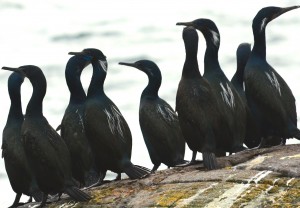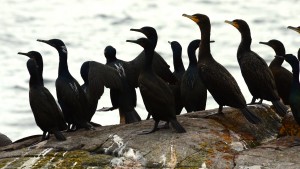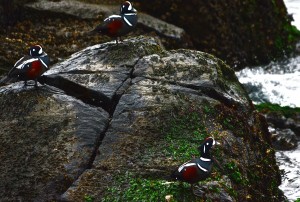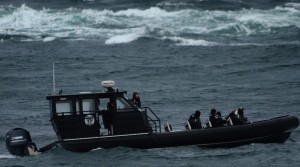It was a blue-sky day at Race Rocks for most of the day, as the wind switched from west to northeast and then finally greyed over. The wind started light in the morning and rose to 36 knots NE, by late afternoon. The barometer climbed out its early morning hole of 993 hPA and dove back in as night fell. As I post the log it is falling past 989. The forecast is calling for the wind to drop and switch to southwest 15 to 25 knots Sunday afternoon and to light Sunday evening.
Four whale watching vessels were observed in the Protected Area today. They seemed to be travelling out to the west probably in search of migrating Gray Whales. They were a little more cautious on the south side, a trend, which tends towards sustainability.
The “sporty” halibut fleet was out fishing today. They anchor for the slackest part of the tide, spaced out like a beads on a necklace around the Ecological Reserve. Not all of them know about (or they choose to ignore) the ‘no go’ and ‘go slow’ limits of the Protected Area .
The reasons for speed limits in the Protected Area are the high density of marine mammals and birds and the location’s inherent dangers. Going slow protects the wildlife from boat strikes and reduces disturbance if boats stay far enough away. The no go areas also extend that protection to human life. I am not sure how many people have died in the waters around Race Rocks, but if it were a road intersection, it would have one of those high crash scene signs, combined with a wildlife crossing sign. I look forward to the day when boaters know and respect the rules. The quickest way for that to happen is by word of mouth and peer pressure. So if you boat in the area, please feel free to give others a friendly ‘reminder’ about the rules You might save their life. For the professional mariners, it is a very important part of being professional.
Chunk, the only remaining Northern Elephant Seal continues to slumber in the same spot. He has completely fried the vegetation where he is stretched out and seems to have lost a lot of mass since I saw him last fall. I guess he has been fairly engrossed with breeding, killing pups and fighting with other males. It must soon be time for him to head off and bulk up in the depths. He has massive “stretch marks” from slimming down to what looks like about 50% of his portly, fall physique.
There were a dozen Bald Eagles here today and the cormorants roosted on Great Race so it was possible to see the subtleties of the neon blue under the Brandt’s Cormorants’ chins and their whiskery white feathers.
The numbers of Canada Geese have risen rapidly, going from six, the day I arrived, to twenty by this afternoon. Canada Geese are protected under the Migratory Bird Regulations, however, they can wreck havoc on a tiny islet like Great Race, which is also used by other species that cannot easily, (unlike Canada Geese), nest elsewhere successfully. Like some people, they are loud, pushy and tend towards aggression, not making the best neighbours for nesting Black Oystercatchers, Pigeon Guillemots and Glaucous-winged Gulls. Although the status of all three of these nesting species, is ‘Least Concern’ as listed by the International Union for the Conservation of Nature (IUCN), we are hoping to keep them that way and discourage geese from staying (under strict permit from Environment Canada).
Other than wild goose chases, chores were routine today including camera and computer care.
- Brandt’s Cormorants
- Both Double-crested and Brandt’s Cormorants can be seen here. Double-crested have the yellowish patch at the base of the bill.
- Harlequins are amazing ducks that need two very different habitats to survive: the coast in winter and alpine streams in summer.
- Wild sea conditions require an excellent boat and a cautious, competent crew.




